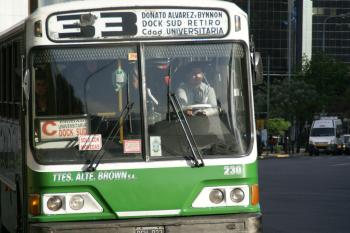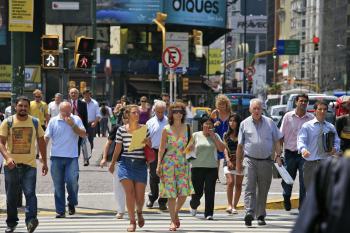Getting Around Buenos Aires
Getting Around Buenos Aires
All City Transport Options: What Locals Use and What’s Best for Tourists
General Overview
Getting around Buenos Aires can be interesting, to say the least! One thing that surprised me about the transport is how everyone relies on it. The subway, or “Subte” as we call it, is pretty efficient and connects most of the key areas. The buses are everywhere, so you may find them a better option at times. Just be ready to decipher the routes; they can be a puzzle!Operating hours for the Subte are generally from 5 AM to midnight, but they stay open until 1 AM on weekends. The buses, on the other hand, run much later, nearly all night. Just to give you an idea of prices: a single ticket on the Subte is about 70 ARS, while a bus ride is around the same. Compared to New York or London, it’s a steal! You can even grab a 10-ride pass (around 600 ARS) which saves you a bit more than buying tickets individually. Oh, and avoid the common mistake of thinking all transport accepts cash. Some routes only take the SUBE card, a must-have for every local.
My first time using the Subte, I accidentally got on the wrong line and ended up at Retiro, which, let me tell you, is a hectic station filled with people! The crowded trains during rush hour can be intense. You’ll be packed in there like a sardine, especially if you’re traveling around 8 AM or 6 PM. One pleasant surprise was how helpful fellow passengers can be. If you look lost, someone will usually point you in the right direction.
If you’re worried about safety, it’s best to avoid using your phone or showing valuables while in transit. Locals usually recommend taking longer panels away from crowded places late at night.
One more tip—when it rains, the buses are often the better choice since the Subte might experience delays due to heavy precipitation. I remember one stormy afternoon when the buses were almost empty while the Subte was delayed for nearly an hour.
So, if you find yourself near Plaza de Mayo and need to hop on a bus, look for the 152 or the 60. You'll get to places like La Boca in no time and see more of the city in a relaxed manner.
If you keep these tips in mind, you’ll navigate the city's transportation with a bit more ease. Remember, a little planning goes a long way!
Types of Transport

popular with tourists
The bus system in Buenos Aires is extensive and covers all major neighborhoods and tourist attractions, making it a convenient way to explore the city. To pay for your bus fare, you'll need an SUBE card, which can be purchased at various kiosks and subway stations for about 100 ARS (as of October 2023), and be sure to load it with sufficient funds (bus fares typically range from 45 to 70 ARS). A key tip for tourists is to familiarize yourself with the bus numbers that service the areas you intend to visit; for example, the number 60 takes you to the iconic neighborhoods of Palermo and Recoleta, while the 130 connects you to Puerto Madero and the Ecological Reserve. Additionally, always board the bus at the front and have your fare ready to tap on the card reader—this speeds up the boarding process and keeps traffic flowing. Finally, remain cautious of your belongings during busy times, as pickpockets can operate in crowded areas.

popular with tourists
The metro in Buenos Aires, known as "Subte," offers an extensive network with six main lines and is frequently the quickest way to navigate the city, especially during rush hours. You can purchase a Subte card (called "SUBE") at kiosks or metro stations for a small fee, and then load it with credit—fares are typically around ARS 50 per ride as of 2023, but always check for updates. A great tourist tip is to take Line A, which stops at key attractions such as Plaza de Mayo and San Telmo, allowing you to experience the heart of the city quickly. To save time, avoid peak usage hours (typically 8-10 AM and 5-7 PM) and try to stand clear of the doors as they will close automatically. Lastly, while the Subte is generally safe, it's wise to keep an eye on your belongings and avoid displaying valuables.

Walking in Buenos Aires is a fantastic way to explore the city's vibrant neighborhoods, including San Telmo, Palermo, and Recoleta, where you can truly appreciate the architecture, street art, and local culture. There’s no cost associated with walking, making it an economical choice for tourists, and it's best to wear comfortable shoes as you'll likely cover several kilometers during your sightseeing. Be sure to carry a map or use a reliable navigation app, as some areas can be confusing, and it's a good idea to stick to well-lit streets, especially at night, for added safety. For a time-saving tip, explore areas in clusters, such as visiting Plaza de Mayo and then strolling through the historic San Telmo market to maximize your experience. Always keep an eye on your belongings, as petty crime can occur in some tourist-heavy areas, so wearing a secure bag that you can easily monitor is advisable.
Taxis in Buenos Aires are widely available and can easily be hailed on the street or booked via phone apps. Fares typically start at around 300 ARS and increase based on distance and time, so always make sure to check the meter. For tourists, it's a good idea to have the address of your destination written down in Spanish to show the driver, as not all will speak English. Be cautious when taking taxis; using authorized and registered taxis (identifiable by their yellow and black color) is crucial for safety. Lastly, consider paying with cash as some drivers may not accept credit cards, and it's advisable to have small bills available to avoid issues with change.

Using an auto in Buenos Aires is a convenient way to explore the city, especially if you're planning to visit areas that are less accessible by public transport, such as Palermo and San Telmo. A common way to get around is by using ride-hailing apps like Uber or Cabify, which typically cost between 200 to 600 ARS for short to medium distances, depending on traffic and surge pricing—payment can be made conveniently through the app itself.
It's advisable to request rides in well-known tourist areas for added safety, and always confirm the license plate before getting in. To save time, consider using the autopistas (highways) that bypass much of the city’s traffic, especially during rush hours from 7 AM to 9 AM and 5 PM to 8 PM. Finally, be aware of potential traffic congestion and always keep your valuables out of sight; street crime can occur, especially in busy areas.
It's advisable to request rides in well-known tourist areas for added safety, and always confirm the license plate before getting in. To save time, consider using the autopistas (highways) that bypass much of the city’s traffic, especially during rush hours from 7 AM to 9 AM and 5 PM to 8 PM. Finally, be aware of potential traffic congestion and always keep your valuables out of sight; street crime can occur, especially in busy areas.
Here you can learn about all types of transport in Buenos Aires. What transport is available, how to reach tourist attractions and which mode of transport is optimal.

